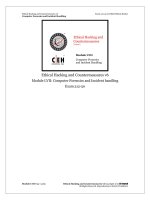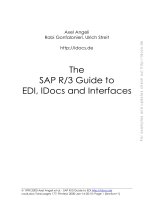Guide to Computer forensics and investigations Chapter 5 Working with Windows and CLI systems
Bạn đang xem bản rút gọn của tài liệu. Xem và tải ngay bản đầy đủ của tài liệu tại đây (964.19 KB, 75 trang )
Guide to Computer Forensics
and Investigations
Fifth Edition
Chapter 5
Working with Windows and CLI
Systems
Objectives
•
•
•
•
Explain the purpose and structure of file systems
Describe Microsoft file structures
Explain the structure of NTFS disks
List some options for decrypting drives encrypted
with whole disk encryption
• Explain how the Windows Registry works
• Describe Microsoft startup tasks
• Explain the purpose of a virtual machine
Guide to Computer Forensics and Investigations, Fifth Edition
© Cengage Learning 2015
2
Understanding File Systems
• File system
– Gives OS a road map to data on a disk
• Type of file system an OS uses determines how
data is stored on the disk
• When you need to access a suspect’s computer to
acquire or inspect data
– You should be familiar with both the computer’s OS
and file systems
Guide to Computer Forensics and Investigations, Fifth Edition
© Cengage Learning 2015
3
Understanding the Boot Sequence
• Complementary Metal Oxide Semiconductor
(CMOS)
– Computer stores system configuration and date and
time information in the CMOS
• When power to the system is off
• Basic Input/Output System (BIOS) or Extensible
Firmware Interface (EFI)
– Contains programs that perform input and output at
the hardware level
Guide to Computer Forensics and Investigations, Fifth Edition
© Cengage Learning 2015
4
Understanding the Boot Sequence
• Bootstrap process
– Contained in ROM, tells the computer how to
proceed
– Displays the key or keys you press to open the
CMOS setup screen
• CMOS should be modified to boot from a forensic
floppy disk or CD
Guide to Computer Forensics and Investigations, Fifth Edition
© Cengage Learning 2015
5
Understanding the Boot Sequence
Guide to Computer Forensics and Investigations, Fifth Edition
© Cengage Learning 2015
6
Understanding Disk Drives
• Disk drives are made up of one or more platters
coated with magnetic material
• Disk drive components
–
–
–
–
–
Geometry
Head
Tracks
Cylinders
Sectors
Guide to Computer Forensics and Investigations, Fifth Edition
© Cengage Learning 2015
7
Understanding Disk Drives
Guide to Computer Forensics and Investigations, Fifth Edition
© Cengage Learning 2015
8
Understanding Disk Drives
Guide to Computer Forensics and Investigations, Fifth Edition
© Cengage Learning 2015
9
Understanding Disk Drives
• Properties handled at the drive’s hardware or
firmware level
–
–
–
–
Zone bit recording (ZBR)
Track density
Areal density
Head and cylinder skew
Guide to Computer Forensics and Investigations, Fifth Edition
© Cengage Learning 2015
10
Solid-State Storage Devices
• All flash memory devices have a feature called
wear-leveling
– An internal firmware feature used in solid-state
drives that ensures even wear of read/writes for all
memory cells
• When dealing with solid-state devices, making a
full forensic copy as soon as possible is crucial
– In case you need to recover data from unallocated
disk space
Guide to Computer Forensics and Investigations, Fifth Edition
© Cengage Learning 2015
11
Exploring Microsoft File Structures
• In Microsoft file structures, sectors are grouped to
form clusters
– Storage allocation units of one or more sectors
• Clusters range from 512 bytes up to 32,000 bytes
each
• Combining sectors minimizes the overhead of
writing or reading files to a disk
Guide to Computer Forensics and Investigations, Fifth Edition
© Cengage Learning 2015
12
Exploring Microsoft File Structures
• Clusters are numbered sequentially starting at 0 in
NTFS and 2 in FAT
– First sector of all disks contains a system area, the
boot record, and a file structure database
• OS assigns these cluster numbers, called logical
addresses
• Sector numbers are called physical addresses
• Clusters and their addresses are specific to a
logical disk drive, which is a disk partition
Guide to Computer Forensics and Investigations, Fifth Edition
© Cengage Learning 2015
13
Disk Partitions
• A partition is a logical drive
• Windows OSs can have three primary partitions
followed by an extended partition that can contain
one or more logical drives
• Hidden partitions or voids
– Large unused gaps between partitions on a disk
• Partition gap
– Unused space between partitions
Guide to Computer Forensics and Investigations, Fifth Edition
© Cengage Learning 2015
14
Disk Partitions
Guide to Computer Forensics and Investigations, Fifth Edition
© Cengage Learning 2015
15
Disk Partitions
• The partition table is in the Master Boot Record
(MBR)
– Located at sector 0 of the disk drive
• MBR stores information about partitions on a disk
and their locations, size, and other important items
• In a hexadecimal editor, such as WinHex, you can
find the first partition at offset 0x1BE
– The file system’s hexadecimal code is offset 3 bytes
from 0x1BE for the first partition
Guide to Computer Forensics and Investigations, Fifth Edition
© Cengage Learning 2015
16
Disk Partitions
Guide to Computer Forensics and Investigations, Fifth Edition
© Cengage Learning 2015
17
Examining FAT Disks
• File Allocation Table (FAT)
– File structure database that Microsoft originally
designed for floppy disks
• FAT database is typically written to a disk’s
outermost track and contains:
– Filenames, directory names, date and time stamps,
the starting cluster number, and file attributes
• Three current FAT versions
– FAT16, FAT32, and exFAT (used by Xbox game
systems)
Guide to Computer Forensics and Investigations, Fifth Edition
© Cengage Learning 2015
18
Examining FAT Disks
• Cluster sizes vary according to the hard disk size
and file system
Guide to Computer Forensics and Investigations, Fifth Edition
© Cengage Learning 2015
19
Examining FAT Disks
• Microsoft OSs allocate disk space for files by
clusters
– Results in drive slack
• Unused space in a cluster between the end of an active
file and the end of the cluster
• Drive slack includes:
– RAM slack and file slack
• An unintentional side effect of FAT16 having large
clusters was that it reduced fragmentation
– As cluster size increased
Guide to Computer Forensics and Investigations, Fifth Edition
© Cengage Learning 2015
20
Examining FAT Disks
Guide to Computer Forensics and Investigations, Fifth Edition
© Cengage Learning 2015
21
Examining FAT Disks
• When you run out of room for an allocated cluster
– OS allocates another cluster for your file, which
creates more slack space on the disk
• As files grow and require more disk space,
assigned clusters are chained together
– The chain can be broken or fragmented
• When the OS stores data in a FAT file system, it
assigns a starting cluster position to a file
– Data for the file is written to the first sector of the first
assigned cluster
Guide to Computer Forensics and Investigations, Fifth Edition
© Cengage Learning 2015
22
Examining FAT Disks
Guide to Computer Forensics and Investigations, Fifth Edition
© Cengage Learning 2015
23
Examining FAT Disks
• When this first assigned cluster is filled and runs
out of room
– FAT assigns the next available cluster to the file
• If the next available cluster isn’t contiguous to the
current cluster
– File becomes fragmented
Guide to Computer Forensics and Investigations, Fifth Edition
© Cengage Learning 2015
24
Deleting FAT Files
• In Microsoft OSs, when a file is deleted
– Directory entry is marked as a deleted file
• With the HEX E5 character replacing the first letter of
the filename
• FAT chain for that file is set to 0
• Data in the file remains on the disk drive
• Area of the disk where the deleted file resides
becomes unallocated disk space
– Available to receive new data from newly created
files or other files needing more space
Guide to Computer Forensics and Investigations, Fifth Edition
© Cengage Learning 2015
25









